时间名词前介词用法口诀
英语教学顺口溜(70首)

英语教学顺口溜(共70首)1、be 的用法口诀:我用am,你用are,is连着他,她,它;单数名词用is,复数名词全用are。
变疑问,往前提,句末问号莫丢弃。
变否定,更容易,be后not莫忘记。
疑问否定任你变,句首大写莫迟疑。
2、人称代词主格的顺口溜:I是我来we复数,你和你们都用you;he,she,it男、女、它,复数一律把they用。
3、时间名词前所用介词的速记歌年月周前要用in,日子前面却不行。
遇到几号要用on,上午下午又是in。
要说某日上下午,用on换in才能行。
午夜黄昏须用at,黎明用它也不错。
at也用在时间前,说“差”可要用上to,说“过”只可使用past,多说多练牢牢记,4、巧记48个国际音标单元音共十二,四二六前中后。
双元音也好背,合口集中八个整。
辅音共计二十八,八对一清又七浊,四个连对也包括。
有气无声清辅音,有声无气浊辅音,发音特点应掌握。
5、巧记long before 和before long:long 在前(long before),“很久前”,long在后(before long),“不久后”。
6、巧记以-o结尾加-es的词有生命的加es,无生命的加s.7、介词顺口溜in 在……里,out 在……外,在旁边的是 beside,靠近的为 by。
on 在……上,under 在……下,above 在上头,below 在底下。
8、英语分数巧记英语分数不费事,母序子基四个字分子若是大于一,分母还须加-s.9、基数词变序数词歌基变序,有规律词尾加上-th(fourth,sixth)一、二、三,特殊例,结尾字母t,d,d(first,second,third) 八去t,九去e,(eighth,ninth)ve要用 f替;(fifth,twelfth)ty将y改成i,th前面有个e。
若是碰到几十几,前用基来后用序。
10、基数词变序数词基变序,很容易,一二三,特殊记,th从四起。
八去t来九去e,遇到ve,f替,ty变为tie,后加th莫迟疑,若想表示几十几,只变个位就可以。
英语介词的用法口诀是什么
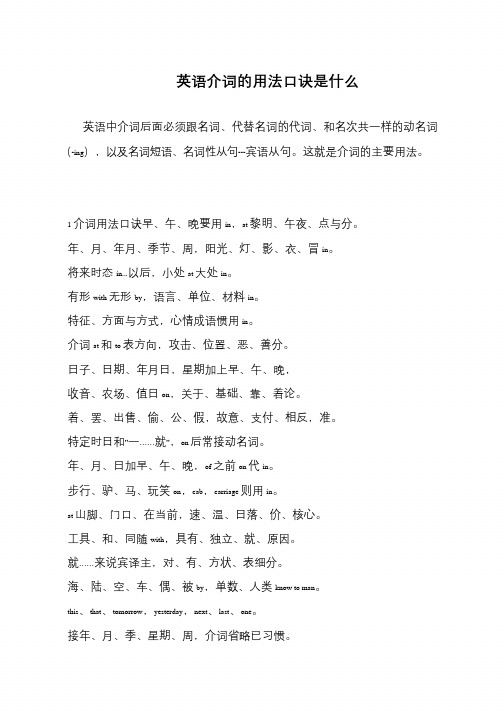
英语介词的用法口诀是什么
英语中介词后面必须跟名词、代替名词的代词、和名次共一样的动名词(-ing),以及名词短语、名词性从句---宾语从句。
这就是介词的主要用法。
1 介词用法口诀早、午、晚要用in,at 黎明、午夜、点与分。
年、月、年月、季节、周,阳光、灯、影、衣、冒in。
将来时态in...以后,小处at 大处in。
有形with 无形by,语言、单位、材料in。
特征、方面与方式,心情成语惯用in。
介词at 和to 表方向,攻击、位置、恶、善分。
日子、日期、年月日,星期加上早、午、晚,
收音、农场、值日on,关于、基础、靠、着论。
着、罢、出售、偷、公、假,故意、支付、相反,准。
特定时日和”一……就”,on 后常接动名词。
年、月、日加早、午、晚,of 之前on 代in。
步行、驴、马、玩笑on,cab,carriage 则用in。
at 山脚、门口、在当前,速、温、日落、价、核心。
工具、和、同随with,具有、独立、就、原因。
就……来说宾译主,对、有、方状、表细分。
海、陆、空、车、偶、被by,单数、人类know to man。
this、that、tomorrow,yesterday,next、last、one。
接年、月、季、星期、周,介词省略已习惯。
初中英语介词的使用口诀表

over、under 正上下,above、below 则不然,
若与数量词连用,混合使用亦无关。
beyond 超出、无、不能,against 靠着,对与反。
besides,except 分内外,among 之内 along 沿。
同类比较 except,加 for 异类记心间。
原状 because of,、 owing to、 due to 表语形容词
初中英语介词的使用口诀表 1
We live at No 87 Beijing Road. 我们住在北京路 87 号。 The hospital is at the end of the street. 医院在这条街的尽头。 与名词所有格连用表示地点,也用 at。如: at my sister’s 在我姐姐家 at the doctor’s 在医务室 (2) 表示空间或范围,用 in。如: What’s in the box? 这盒子里有什么? He lives in Paris with his wife. 他同他妻子住在巴黎。 但有时两者可换用。如: The meeting was held at [in] the hotel. 会议在宾馆举行。 (3) at 与 in 的另一个区别是:at 用于指较小的地方,而 in 用于指较大的地方。如: in Shanghai 在上海 at the station 在车站 但是,大与小是相对的,有时随着说话者的着眼点不同,大地方也可能用 at(比如把一个大地方看作一 个点时)。如: Our plane refuelled at London. 我们的飞机在伦敦加油。 We stopped for an hour at Moscow on our way to Paris. 我们在去巴黎的途中在莫斯科停了 1 个小时。 (4) 介词 on 用于地点,主要指在某物的表面。如: What’s on the table? 桌上有什么? There’s a wallet lying on the ground. 地上有个钱包。 注:在少数搭配中,也用介词 on。如: He works on a farm. 他在农场工作。 3. 在某些搭配中,三者的区别与英国英语和美国英语有关: in the street (英) / on the street (美) 在街上 in the road (英) / on the road (美) 在路上 in the team (英) / on the team (美) 在这个队 at the weekend (英) / on the weekend (美) 在周末 at weekends (英) / on weekends (美) 在周末 4. 有时三者的差别与搭配习惯和用法有关: in bed / on the bed 在床上(from ) in the tree (多指树外之物) / on the tree (多指树本身之物) 在树上
介词的使用方法口诀

介词的使用方法口诀介词是连接名词、代词或动词与其他词语的一种虚词,它在句子中起着非常重要的作用。
正确使用介词不仅可以使语言表达更加准确,而且还可以增强语言的表达能力。
下面就介绍一下介词的使用方法口诀,希望能帮助大家更好地掌握介词的用法。
一、表示地点的介词。
1. in,表示在某个范围内或大的地点,如in the room(在房间里)、in China (在中国)。
2. on,表示在某个表面或小的地点,如on the table(在桌子上)、on the wall (在墙上)。
3. at,表示在某个具体的地点或场所,如at home(在家)、at the station(在车站)。
二、表示时间的介词。
1. in,表示在某个时间段内,如in the morning(在早晨)、in July(在七月份)。
2. on,表示在某一天或日期,如on Monday(在星期一)、on January 1st(在1月1日)。
3. at,表示在某个具体的时间点,如at 3 o'clock(在3点钟)、at noon(在中午)。
三、表示原因的介词。
1. because of,表示由于,引起某种原因,如because of the rain(因为下雨)。
2. due to,表示由于,常用于正式场合,如due to the bad weather(由于恶劣的天气)。
四、表示方式的介词。
1. by,表示通过某种方式或手段,如by bus(乘坐公交车)、by email(通过电子邮件)。
2. with,表示伴随或使用某种方式,如with a smile(带着微笑)、with great care(非常小心地)。
五、表示比较的介词。
1. than,用于比较级句式中,表示比较的对象,如taller than me(比我高)。
2. as,用于肯定句中,表示与某人或某物相同,如as tall as me(和我一样高)。
六、其他常用介词。
英语语法用法顺口溜(巧记)
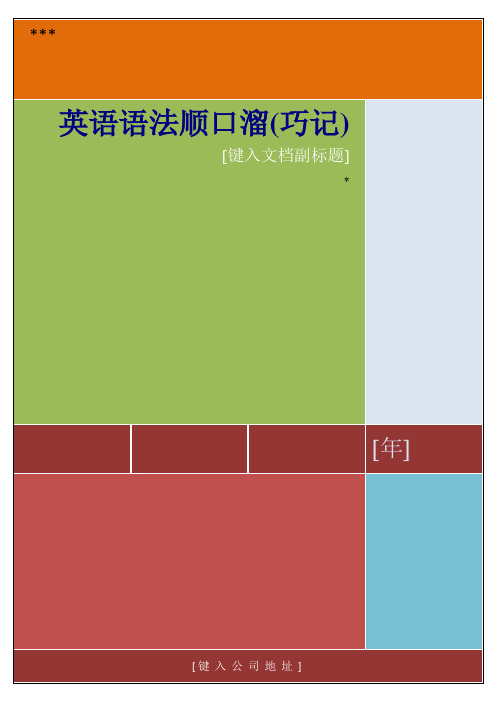
英语语法顺口溜(巧记).英语学习动词为纲“滚雪球” 难易编组抓循环同类归纳印象深图示介词最直观混淆多因形音义反义词语成对念构词方法不可忘习惯用语集中练词不离句法最好课外阅读莫间断be 的用法口诀我用am,你用are,is连着他,她,它;单数名词用is,复数名词全用are。
变疑问,往前提,句末问号莫丢弃。
变否定,更容易,be后not莫忘记。
疑问否定任你变,句首大写莫迟疑。
时间名词前所用介词的速记歌年月周前要用in,日子前面却不行。
遇到几号要用on,上午下午又是in。
要说某日上下午,用on换in才能行。
午夜黄昏须用at,黎明用它也不错。
at也用在明分前,说“差”可要用上to,说“过”只可使用past,多说多练牢牢记,莫让岁月空蹉跎。
记住f(e)结尾的名词复数妻子持刀去宰狼,小偷吓得发了慌;躲在架后保己命,半片树叶遮目光。
巧记48个国际音标单元音共十二,四二六前中后。
双元音也好背,合口集中八个整。
辅音共计二十八,八对一清又七浊,四个连对也包括。
有气无声清辅音,有声无气浊辅音,发音特点应掌握。
非谓语动词的一些特殊用法后只接不定式作宾语的一些常用特殊谓语动词动词后,不定式,want, hope和wish,agree, decide, mean, manage, promise,expect, pretend,且说两位算在此,要记牢,要记住,掌握它们靠自己。
英语学习小窍门后接动词不定式做宾语补足语省略不定式符号“to”的一些常用特殊动词一些动词要掌握,have, let和make,此三动词是使役,“注意”“观察”“听到”see,还有feel和watch,使用它们要仔细,后接“宾补”略去“to”,此点千万要牢记除此之外,还可以掌握“八字言”,一感feel,二听hear, listen to, 三让have, let, make,四看see, look at, observe, watch后只接动名词做宾语的一些常用特殊动词特殊动词接“动名”,使用它们要记清,“放弃”“享受”可“后悔”,“坚持”“练习”必“完成”,“延期”“避免”非“介意”掌握它们今必行。
英语介词用法口诀歌

英语介词用法口诀歌英语介词用法口诀歌介词在职称的中至关重要,时间前面会用到介词,地点前面也会用到介词,有时候它们还会和量词连起来用,介词的用法你知道多少?下面是网校整理的一些介词用法口诀,掌握了介调用法口诀,就不易出错。
早、午、晚要用in,at黎明、午夜、点与分。
年、月、年月、季节、周,阳光、灯、影、衣、冒in.将来时态in……以后,小处at大处in.有形with无形by,语言、单位、材料in.特征、方面与方式,心情成语惯用in.介词at和to表方向,攻击、位置、恶、善分。
日子、日期、年月日,星期加上早、午、晚。
收音、农场、值日on,、基础、靠、着论。
着、罢、出售、偷、公、假,故意、支付、相反,准。
特定时日和“一……就”,on后常接动名词。
年、月、日加早、午、晚,of之前on代in.步行、驴、马、玩笑on,cab,carriage则用in.at山脚、门口、在当前,速、温、日落、价、核心。
工具、和、同随with,具有、独立、就、原因。
就……来说宾译主,对、有、方状、表细分。
海、陆、空、车、偶、被by,单数、人类know to man.this、that、tomorrow,yesterday,next、last、one.接年、月、季、星期、周,介词省略已习惯。
over、under正上下,above、below则不然,若与数量词连用,混合使用亦无关。
‘beyond超出、无、不能,against靠着,对与反。
besides,except分内外,among之内along沿。
同类比较except,加for异类记心间。
原状because of、owing to、due to表语形容词under后接修、建中,of、from物、化分。
before、after表一点,ago、later表一段。
before能接完成时,ago过去极有限。
since以来during间,since时态多变换。
与之相比beside,除了last but one.复不定for、找、价、原,对、给、段、去、为、作、赞。
时间名词前介词用法口诀

时间名词前介词用法口诀:年前周前要用in,具体日子要用on。
遇到几号也用on,上午下午得是in。
要说某日上下午,用on换in记清楚。
午夜黄昏用at,黎明用它也不错。
at用在时分前,说“差”可要用上to。
说"过''要用past1.表示地点位置的介词1)at ,in, on, to,forat (1)表示在小地方; (2)表示“在……附近,旁边”in (1)表示在大地方; (2)表示“在…范围之内”。
on 表示毗邻,接壤,“在……上面”。
to 表示在……范围外,不强调是否接壤;或“到……”2)above, over, on 在……上above 指在……上方,不强调是否垂直,与 below相对;over指垂直的上方,与under相对,但over与物体有一定的空间,不直接接触。
on表示某物体上面并与之接触。
The bird is flying above my head.There is a bridge over the river.He put his watch on the desk.3)below, under 在……下面under表示在…正下方below表示在……下,不一定在正下方There is a cat under the table.Please write your name below the line.4)in front [frant]of, in the front of在……前面in front of…意思是“在……前面”,指甲物在乙物之前,两者互不包括;其反义词是behind(在……的后面)。
There are some flowers in front of the house.(房子前面有些花卉。
) in the front of 意思是“在…..的前部”,即甲物在乙物的内部.反义词是at the back of…(在……范围内的后部)。
介词的用法区分规则口诀

介词的用法区分规则口诀一、介词的基本概念和分类介词是语法中的一种词类,用于引导名词、代词或者名词性短语与其他成分之间的关系。
通过在句子中充当桥梁的作用,介词能够表示时间、地点、方向、方式等各种语义关系。
根据其功能和用法不同,介词可以分为以下几类:1. 时间介词:表示时间范围或具体的时间点,如in(在……之内)、on (在……上)、at(在……时候)等;2. 地点介词:表示位置或者方向关系,如in(在……里面)、on(在……上面)、at(在……附近)等;3. 方式介词:表示动作或状态发生的方式,如by(通过)、with(用)、without(没有)等;4. 原因介词:表示原因或理由,如because of(因为)、due to(由于)等;5. 目的介词:表示目的或意图,如for(为了)等;6. 结果/比较介词:表示结果或进行比较,如so that(以便)、than(比)等;二、使用技巧和区分规则1. 区分in, on, at- in 用于表达较大范围、较长时间内的位置或时间,如in the city(在城市里)、in winter(在冬天);- on 用于表达较小范围、较短时间内的位置或时间,如on the table(在桌子上)、on Monday(在星期一);- at 用于精确地点或特定时间,如at the library(在图书馆)、at 8 o'clock (在八点钟)。
2. 区分by, with, without- by 表示通过某种手段或方法,如by car(乘车)、communicate by email (通过电子邮件交流);- with 表示使用某种工具、器材等协助完成某事,如write with a pen(用钢笔写);- without 则表示没有某种条件或情况下进行某事,如drive without a license (没有驾照开车)。
3. 区分because of, due to- because of 强调的是起因,后面接名词或名词性短语,如because of the rain (因为下雨);- due to 强调的是结果,后面接名词性短语或动名词短语,常用来修饰由前面动作引起的后果,在句中通常位于主语之后。
时间名词前所用介词1

时间名词前所用介词时间名词前所用介词的速记歌年月周前要用in,日子前面却不行。
遇到几号要用on,上午下午又是in。
要说某日上下午,用on换in才能行。
午夜黄昏须用at,黎明用它也不错。
at也用在时分前,说“差”可要用上to,说“过”只可使用past,多说多练牢牢记,莫让岁月空蹉跎。
下面就时间概念的介词用法做一简要介绍和比较。
1.at表示时间概念的某一个点。
(在某时刻、时间、阶段等)。
at1:00(dawn,midnight,noon)在一点钟(黎明、午夜、中午)these are our chief tasks at the present stage.这些就是我们现阶段的主要任务。
2.on1)表示具体日期。
they arrived in shanghai on may25.他们在五月二十五日到达上海。
注:(1)关于"在周末"的几种表示法:at(on)the weekend在周末---特指at(on)weekends在周末---泛指over the weekend在整个周末during the weekend在周末期间(2)在圣诞节,应说"at christmas而不说"on christmas2)在(刚……)的时候。
on reaching the city he called up his parents.一到城里他就给父母打了一个电话。
3.in1)表示"时段"、"时期",在多数情况下可以和dur-ing互换,前者强调对比,后者强调持续。
in(during)1988(december,the20th century)在一九八八年(十二月、二十世纪)i returned to beijing in the middle of june.我是六月中回北京的。
但如果表示"在某项活动的期间",则只能用during。
语文介词的用法和位置口诀

语文介词的用法和位置口诀一、介词的概念及基本用法介词是语言中常用的一种虚词,用来引导名词短语或代词短语与其他成分之间的关系。
介词通常在句子中充当修饰、补充、限制或指示等作用。
在汉语中,介词的使用非常广泛,掌握好介词的用法和位置对于正确理解和运用语言至关重要。
二、常见介词及其使用场景1. 位置类介词:在、下、上、前、后等这类介词主要表示物体所处的具体位置或方向。
例如:“书放在桌子上。
”“他站在门口等我。
”需要注意的是,这些位置类介词往往与动作动词连用,表达一个行为发生在某个特定的地点。
2. 时间类介词:从、到、在、以后等时间类介词主要表示时间段或事件发生的时间顺序。
例如:“从早上到晚上,他都在学习。
”“我们可以聚会之后去看电影。
”这些介词往往与表示时间和动作的短语连用,并起到连接两者关系的作用。
3. 方式类介词:以、为、凭借等方式类介词主要表示行动的方式或手段。
比如:“以他的聪明才智,他一定会成功。
”“我凭借努力取得了好成绩。
”这些介词通常来跟一个名词或动名词连用,表示通过什么方式或手段实现某种行为。
4. 条件类介词:如果、只要、无论等条件类介词主要表示某种条件下会发生的结果。
例如:“如果你考试不及格,就得重新考。
”“无论外面多冷,只要我们有爱心就不怕。
”这些介词往往与条件状语从句连用,表达某个条件下可能出现的情况。
5. 归属类介词:关于、属于、拥有等归属类介词主要表示某物所具有的特性或者是属于谁的。
例如:“这本书关于历史知识。
”“房子属于我父母所有。
”这些介词通常与名词短语连用,并说明其所具有的特定属性。
三、介词位置口诀为了更好地掌握和运用介词,我们可以记住以下简单易懂的口诀:前高后起向后看,命脉与其内外移。
此前须随名悠转,那后字面齐整漂。
例行出入同在后,条件陪伴前头翘。
方式如圈尊之化,所有解放属心调。
这个口诀的意思是:1. 前高后起:介词通常位于名词短语或代词短语之前,例如“在房子里”、“对他来说”。
英语中介词的用法

英语中介词的用法口诀早、午、晚要用in,at黎明、午夜、点与分。
年、月、年月、季节、周,阳光、灯、影、衣、冒in。
将来时态in...以后,小处at大处in。
有形with无形by,语言、单位、材料in。
特征、方面与方式,心情成语惯用in。
介词at和to表方向,攻击、位置、恶、善分。
日子、日期、年月日,星期加上早、午、晚,收音、农场、值日on,关于、基础、靠、着论。
着、罢、出售、偷、公、假,故意、支付、相反,准。
特定时日和"一……就",on后常接动名词。
年、月、日加早、午、晚,of之前on代in。
步行、驴、马、玩笑on,cab,carriage则用in。
at山脚、门口、在当前,速、温、日落、价、核心。
工具、和、同随with,具有、独立、就、原因。
就……来说宾译主,对、有、方状、表细分。
海、陆、空、车、偶、被by,单数、人类know to man。
this、that、tomorrow,yesterday,next、last、one。
接年、月、季、星期、周,介词省略已习惯。
over、under正上下,above、below则不然,若与数量词连用,混合使用亦无关。
'beyond超出、无、不能,against靠着,对与反。
besides,except分内外,among之内along沿。
同类比较except,加for异类记心间。
原状because of,、owing to、due to表语形容词under后接修、建中,of、from物、化分。
before、after表一点, ago、later表一段。
before能接完成时,ago过去极有限。
since以来during间,since时态多变换。
与之相比beside,除了last but one。
复不定for、找、价、原,对、给、段、去、为、作、赞。
快到、对、向towards,工、学、军、城、北、上、南。
but for否定用虚拟,复合介词待后言。
(完整版)英语中时间名词前介词的用法

时间名词前介词的用法一、用in的场合(1)表示“在某年/月/季节”这个含义时,须用介词in。
例如:in 1980.(2)表示“从现在起一段时间以后”时,须用介词in。
例如:They will go to see you in a week. (3)表示“在某世纪”时,须用介词in. 例如:This machine was invented in the eighteenth century. (4)表示” 在早上、下午、晚上“须用介词in. 例如: in the morning / evening / afternoon二、用on的场合(1)表示“在具体的某一天”或“(在具体的某一天的)早上、中午、晚上”等,须用介词on。
例如:on May 10th,1982,on a rainy morning,on a summer afternoon.练习:This festival is a cheerful occasion, for ____this day, the dead are said to return to their homes and they are welcomed by the living这是个欢乐的日子,据说这一天,死者回家而活着的人欢迎他们Mother's Day is ______the second Sunday of May.It’s a day to thank mothers.On thatday mothers usually get flowers and cards from their children.(2)表示“在星期几”或“在星期几的早上、中午、晚上”等,须用介词on。
例如:on Saturday ,on Saturday morning, on weekdays在平时/周日(3)表示“在某一节日”时,须用介词on。
例如:on Mid-autumn Festival, on Teachers' Day.注意:当morning,evening,afternoon被of短语修饰,习惯上用in,而不用on.例如:in the early morning of September 10th 在9月10的清晨;in the late afternoon of September 12th 在9月12日的傍晚。
介词的用法规则口诀
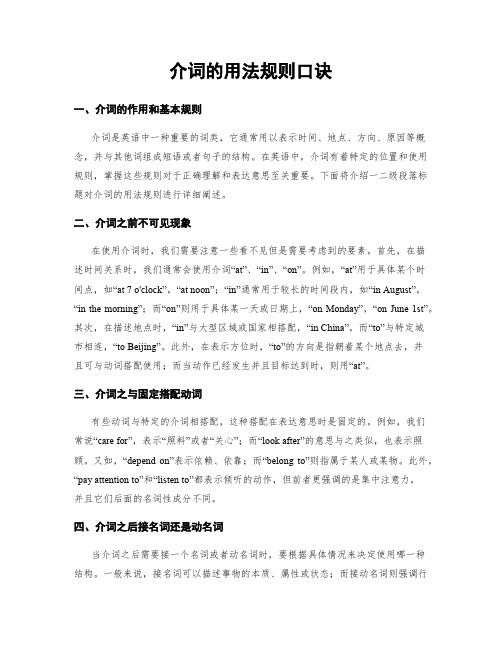
介词的用法规则口诀一、介词的作用和基本规则介词是英语中一种重要的词类,它通常用以表示时间、地点、方向、原因等概念,并与其他词组成短语或者句子的结构。
在英语中,介词有着特定的位置和使用规则,掌握这些规则对于正确理解和表达意思至关重要。
下面将介绍一二级段落标题对介词的用法规则进行详细阐述。
二、介词之前不可见现象在使用介词时,我们需要注意一些看不见但是需要考虑到的要素。
首先,在描述时间关系时,我们通常会使用介词“at”、“in”、“on”。
例如,“at”用于具体某个时间点,如“at 7 o'clock”,“at noon”;“in”通常用于较长的时间段内,如“in August”,“in the morning”;而“on”则用于具体某一天或日期上,“on Monday”,“on June 1st”。
其次,在描述地点时,“in”与大型区域或国家相搭配,“in China”,而“to”与特定城市相连,“to Beijing”。
此外,在表示方位时,“to”的方向是指朝着某个地点去,并且可与动词搭配使用;而当动作已经发生并且目标达到时,则用“at”。
三、介词之与固定搭配动词有些动词与特定的介词相搭配,这种搭配在表达意思时是固定的。
例如,我们常说“care for”,表示“照料”或者“关心”;而“look after”的意思与之类似,也表示照顾。
又如,“depend on”表示依赖、依靠;而“belong to”则指属于某人或某物。
此外,“pay attention to”和“listen to”都表示倾听的动作,但前者更强调的是集中注意力,并且它们后面的名词性成分不同。
四、介词之后接名词还是动名词当介词之后需要接一个名词或者动名词时,要根据具体情况来决定使用哪一种结构。
一般来说,接名词可以描述事物的本质、属性或状态;而接动名词则强调行为或动作的发生和进行。
例如,“I have a book on the table.”这里使用了名词形式,在说明书籍在桌子上有一个位置。
介词的用法记忆口诀顺口溜
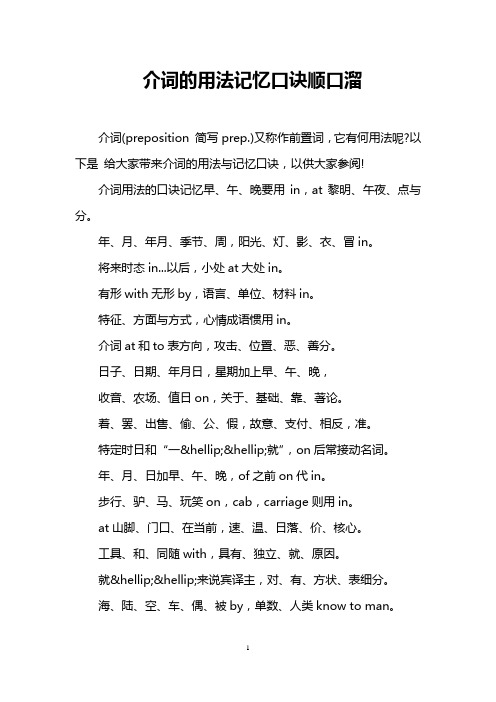
介词的用法记忆口诀顺口溜介词(preposition 简写prep.)又称作前置词,它有何用法呢?以下是给大家带来介词的用法与记忆口诀,以供大家参阅!介词用法的口诀记忆早、午、晚要用in,at黎明、午夜、点与分。
年、月、年月、季节、周,阳光、灯、影、衣、冒in。
将来时态in...以后,小处at大处in。
有形with无形by,语言、单位、材料in。
特征、方面与方式,心情成语惯用in。
介词at和to表方向,攻击、位置、恶、善分。
日子、日期、年月日,星期加上早、午、晚,收音、农场、值日on,关于、基础、靠、著论。
着、罢、出售、偷、公、假,故意、支付、相反,准。
特定时日和“一……就”,on后常接动名词。
年、月、日加早、午、晚,of之前on代in。
步行、驴、马、玩笑on,cab,carriage则用in。
at山脚、门口、在当前,速、温、日落、价、核心。
工具、和、同随with,具有、独立、就、原因。
就……来说宾译主,对、有、方状、表细分。
海、陆、空、车、偶、被by,单数、人类know to man。
this、that、tomorrow,yesterday,next、last、one。
接年、月、季、星期、周,介词省略已习惯。
over、under正上下,above、below则不然,若与数量词连用,混合使用亦无关。
‘beyond超出、无、不能,against靠着,对与反。
besides,except分内外,among之内along沿。
同类比较except,加for异类记心间。
原状because of,、owing to、due to表语形容词under后接修、建中,of、from物、化分。
before、after表一点, ago、later表一段。
before能接完成时,ago过去极有限。
since以来during间,since时态多变换。
英语语法顺口溜记忆方法

be 的用法口诀我用am,你用are,is连着他,她,它;单数名词用is,复数名词全用are.变疑问,往前提,句末问号莫丢弃变否认,更简单,be后not莫忘记疑问否认任你变,句首大写莫迟疑时间名词前所用介词的速记歌年月周前要用in,日子前面却不行遇到几号要用on,上午下午又是in.要说某日上下午,用on换in才能行午夜黄昏须用at,拂晓用它也不错at也用在明分前,说差可要用上to,说过只可使用past,多说多练牢牢记,莫让岁月空蹉跎可数名词的复数变化规律[1]:名词复数有规律,一般词尾加s;辅音字母+y型,变y为i,es;ch,sh真有趣,s,x,es;f,fe真小气,字母v来把它替,es在后别忘记;字母o来真奇妙,有生命来es,没有生命+s.可数名词复数特别变化规律[2]:中日好友来聚会,绵羊、鹿、鱼把家回。
男士、女士a变e;牙〔齿〕、脚双o变双e;孩子们想去天安门,原形后面r、e 、n;老鼠本来爱大米,mice,ice和rice.注:中Chinese,日Japanese,好友people.绵羊sheep,鹿deer,鱼fish 〔这些单词单复数一样〕man--men woman--women tooth--teeth foot--feet child--children mouse--mice一般现在时态〔一〕I、we、you、they作主语,动词原形后面跟;否认句,更简单,动词前面加don't;疑问句,别焦急,句首Do,来帮你,后面问号别忘记;肯定答复用Yes,I、we、you、they加上do;否认答复要用No,I、we、you、they加don't.〔二〕主语三单他、她、它,动三形式后面压,词尾一般s加;辅音字母+y型,变y为i,es;ch,sh真有趣,s,x,es;三个特别那里去?has、goes和does;否认句,记住它,动词前面doesn't;疑问句,别焦急,句首Does,来帮你;肯定答复用Yes,he、she、it加does;否认答复要用No,he、she、it、doesn't;Does、doesn't来帮你,后面动词定注意,恢复原形要切记。
介词的用法总结
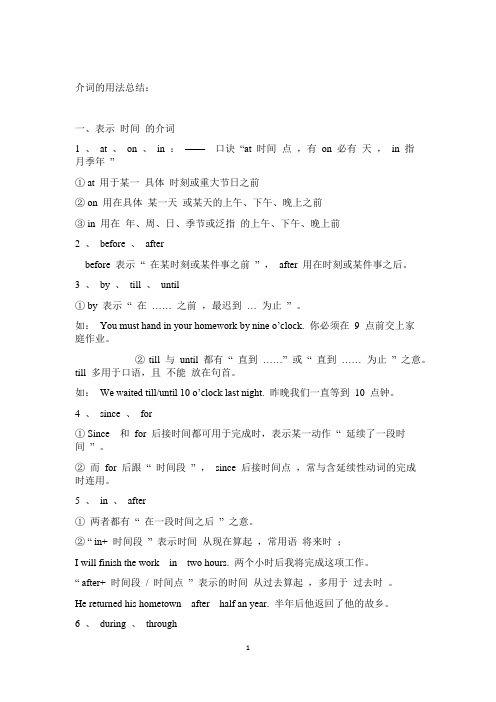
介词的用法总结:一、表示时间的介词1 、at 、on 、in :——口诀“at 时间点,有on 必有天,in 指月季年”① at 用于某一具体时刻或重大节日之前② on 用在具体某一天或某天的上午、下午、晚上之前③ in 用在年、周、日、季节或泛指的上午、下午、晚上前2 、before 、afterbefore 表示“ 在某时刻或某件事之前” ,after 用在时刻或某件事之后。
3 、by 、till 、until① by 表示“ 在…… 之前,最迟到… 为止” 。
如:You must hand in your homework by nine o’clock. 你必须在9 点前交上家庭作业。
②till 与until 都有“ 直到……” 或“ 直到…… 为止” 之意。
till 多用于口语,且不能放在句首。
如:We waited till/until 10 o’clock last night. 昨晚我们一直等到10 点钟。
4 、since 、for① Since 和for 后接时间都可用于完成时,表示某一动作“ 延续了一段时间” 。
②而for 后跟“ 时间段” ,since 后接时间点,常与含延续性动词的完成时连用。
5 、in 、after①两者都有“ 在一段时间之后” 之意。
② “ in+ 时间段” 表示时间从现在算起,常用语将来时;I will finish the work in two hours. 两个小时后我将完成这项工作。
“ after+ 时间段/ 时间点” 表示的时间从过去算起,多用于过去时。
He returned his hometown after half an year. 半年后他返回了他的故乡。
6 、during 、through① during 意为“ 在一段时间内” 的行为或状态,与一段时间的整体连用。
I made many good friends during my visit to China. 我在中国参观期间交了很多好朋友。
汉语介词口诀

汉语介词口诀一、汉语介词概述汉语介词是一种虚词,主要用于表示名词、代词与其他成分之间的语法关系。
它们可分为时间介词、地点介词、方向介词、方式介词、原因介词和目的介词等。
介词与动词、形容词、副词等实词相结合,可以构成介词短语,表示特定的语法意义。
二、常见介词分类与用法1.时间介词时间介词主要用于表示时间状语,如:在、于、从、到、自从、截至等。
例如:- 我明天要去开会。
(在+明天)- 自从来了新经理,公司业绩越来越好。
(自从+来)2.地点介词地点介词表示名词、代词所在的位置,如:在、上、下、里、外、附近等。
例如:- 书在桌子上。
(在+桌子上)- 超市离家不远。
(不远+家)3.方向介词方向介词表示方向或动作的趋向,如:向、朝、往、背、离开等。
例如:- 他朝着窗户走去。
(朝着+窗户)- 离开市区,我们来到了乡下。
(离开+市区)4.方式介词方式介词表示动作的方式或手段,如:用、靠、乘、沿、通过等。
例如:- 我靠走路去上班。
(靠+走路)- 他们乘船游览了长江。
(乘+船)5.原因介词原因介词表示动作的原因,如:因为、由于、凭、靠等。
例如:- 因为他生病了,所以没来。
(因为+生病)- 老师表扬了她,因为她勤奋好学。
(因为+勤奋好学)6.目的介词目的介词表示动作的目的,如:为了、为、以便、好等。
例如:- 他努力学习,为了考上好大学。
(为了+考上好大学)- 我帮你忙,以便你顺利完成任务。
(以便+顺利完成任务)三、介词辨析与应用技巧在实际应用中,不同介词之间有时容易混淆。
为避免误用,我们需掌握它们之间的细微差别。
如:- “在”与“于”:二者都表示位置,但“在”强调存在或位于某个地方,而“于”强调动作发生的时间或地点。
- “从”与“由”:二者都表示起点,但“从”强调起点和终点的相对关系,而“由”强调动作的来源或途径。
四、实战演练与练习为了更好地掌握汉语介词的用法,请完成以下练习:1.用适当的时间介词填空:- 我________(明天)去公园散步。
英语介词的用法口诀有哪些

介词的用法一直都是英语语法中一个非常重要的部分。
介词又称作前置词,表示名词、代词等与句中其他词的关系,在句中不能单独作句子成分。
以下是小编查询整理的英语介词用法口诀,一起来看看吧!
英语介词的用法口诀
1、Before时空在之前,after之后off远。
?
直上over,above斜,under、below下相反。
?
直到till,on表面,?
里面穿过是through,表面穿过across,
到上面onto,进入into,in?front?of前,for因缘。
?
By表旁边,in里面,with伴随,by车船。
?
时间地点at、in、on,二者between多among。
Behind后面beside旁,附近near沿着along。
?
From来自,like像,表示目的for,to当。
?
Of所属,周围round,向上up向下down。
2、上午、晚上要用in,at黎明、黄昏、午夜、点与分。
?
说“差”可要用上to,说“过”只用past。
?
年、月、年月、季节、周,阳光、灯影、衣帽in。
?
将来时态in“…以后”,小处at大处in。
时间名词前介词用法口诀
年月周前要用in,具体日子却要禁。
遇到几号要用on,上午下午又是in。
要说某日上下午,用on换in记清楚。
午夜黄昏用at,黎明用它也不错。
at用在时分前,“差”用to来“过”用past。
多说多练牢牢记,莫让岁月空蹉跎。
常用介词短语及巧记忆

常用介词短语及巧记忆at用在时刻前,亦与正午、午夜连,黎明、终止和开端,at与之紧接着相伴。
周月季年长时间,in须放在其前面,泛指一晌和傍晚,也要放在in后边。
on指特定某一天,日期、星期和节日前,某天上下和夜晚,依然要在on后站。
今明昨天前后天,上下这那每之前,at、in、on都不用,此乃习惯记心间。
on,at,in这三个常用介词都可以表示时间和地点,但具体用法不同,多数学生对它们混淆不清。
现在只要记住了口诀,就可避免at,on,in的种种误用。
1. on,in,at表示时间on“在具体某一天”①“当某时”,动名词,arrival,death前;early,late位句先②,用in一般“傻“下”“晚”;on用于天,in用于月、季、年③;限定三时in要变。
④at是个时间点,“工作”“时刻”与“圣诞”⑤。
at noon(night),in the day,习惯用语记心间。
注:①on表示在具体某一天及具体某一天的上午、下午和晚上。
例On mother's Day, we should send flowers to our mother. 母亲节,我们应该送花给我们的母亲。
On my arrival home,I found he had gone already.当我到家时,我发现他已经走了。
②当early,late用于句首修饰介词短语时,尽管表示具体某一天的上午、下午、晚上,都要用in,泛指一般的上、下午,晚上也用in 。
例Early in the morning of National Day,I got up to catch the first bus to the zoo.国庆节一清早,我便起床往赶到动物园的第一班公共汽车。
My father begins work at 8:00 in the morning and stops work at 4:00 in the afternoon. 我父亲上午8点上班,下午4点放工。
- 1、下载文档前请自行甄别文档内容的完整性,平台不提供额外的编辑、内容补充、找答案等附加服务。
- 2、"仅部分预览"的文档,不可在线预览部分如存在完整性等问题,可反馈申请退款(可完整预览的文档不适用该条件!)。
- 3、如文档侵犯您的权益,请联系客服反馈,我们会尽快为您处理(人工客服工作时间:9:00-18:30)。
具体日子却要用on
遇到几号要用on
上午下午又是in
要说某日上下午
用on换in记清楚
午夜黄昏用at
黎明用它也不错
at用在时分前
说“差”可要用上to
说"过''要用past
[编辑本段]3.表示运动方向的介词:
across, through 通过,穿过
besides 除……之外,包括在内。
Except for Mr. Wang, we went to see the film.(王先生没去)
Besides Mr. Wang, we also went to see the film.(王先生也去了)
3回答者:
�
我们的教室前边有一块黑板。
Our teacher stands in the front of the classroom.
我们的老师站在教室前.(老师在教室里)
5)beside,behind
beside 表示在……旁边
behind 表示在……后面
[编辑本段]2.表示时间的介词
他一直在这儿工作。 He began to work here after 1965.
(指一点时间,强调时间点)从1965年以后,他开始在这儿工作。
4)after, behind 在……之后
after主要用于表示时间;
behind主要用于表示位置。
时间名词前介词用法口诀
他们从小就是好朋友。 (1)since the war是指"自从战争结束以来",若指"自从战争开始以来",须说"since the
beginning of the war"。
(2)不要将since与after混淆。
比较:He has worked here since 1965.(指一段时间,强调时间段)自从1965年以来,
2)in, after 在……之后
“in +段时间”表示将来的一段时间以后;
“after+段时间”表示过去的一段时间以后;
“after+将来的时间点”表示将来的某一时刻以后。
3)from, since 自从……
from仅说明什么时候开始,不说明某动作或情况持续多久;
英语中按动词后可否直接跟宾语,可以把动词分成两种:及物动词与不及物动词。
及物动词:字典里词后标有vt. 的就是及物动词。及物动词后必须跟有动作的对象(即宾语),并且可直接跟宾语。
如see 看见 (vt.) +宾语 I can see a boy.
不及物动词:字典里词后标有vi. 的就是不及物动词。不及物动词后不能直接跟有动作的对象(即宾语)。若要跟宾语,必须先在其后添加上某个介词,如to,of ,at后方可跟上宾语。具体每个动词后究竟加什么介词就得联系动词短语了,如listen to,look at….
below表示在……下,不一定在正下方
There is a cat under the table.
Please write your name below the line.
4)in front [frant]of, in the front of在……前面
in front of…意思是“在……前面”,指甲物在乙物之前,两者互不包括;其反义词是behind(在……的后面)。
There are some flowers in front of the house.(房子前面有些花卉。)
in the front of 意思是“在…..的前部”,即甲物在乙物的内部.反义词是at the back of…(在……范围内的后部)。
There is a blackboard in the front of our classroom.
on表示具体某一天及其早、中、晚。
如on May 1st, on Monday, on New Year’s Day, on a cold night in January, on a fine morning, on Sunday afternoon等。
at表示某一时刻或较短暂的时间,或泛指圣诞节,复活节等。
between, among
between指在两个人或两个事物之间;
among指在三个或三个以上的人或事物之间。
[编辑本段]5.表示其他意义的介词
1)on ,about 关于
on 表示这本书,这篇文章或演说是严肃的,或学术性的,可供专门研究这一问题的人阅读;
about表示内容较为普通,不那么正式。
2)by, with, in 表示方法、手段、工具
by 以……方法、手段或泛指某种交通工具;
with 表示用 …工具、手段,一般接具体的工具和手段;
in 表示用…方式,用…语言(语调、笔墨、颜色)等;
3)except, besides 除了
except 除……之外,不包括在内;
since表示某动作或情况持续至说话时刻,通常与完成时连用。since表示"自(某具体时间)以来",常用作完成时态谓语
的时间状语。
since liberation(1980)自从解放(1980年)以来 They have been close friends since childhood.
in (1)表示 在大地方; (2)表示“在…范围之
to 表示在……范围外,不强调是否接壤;或“到……”
2)above, over, on 在……上
above 指在……上方,不强调是否垂直,与 below相对;
over指垂直的上方,与under相对,但over与物体有一定的空间,不直接接触。
如at 3:20, at this time of year, at the beginning of, at the end of …, at the age of …, at Christmas, at night, at noon, at this moment等。
注意:在last, next, this, that, some, every 等词之前一律不用介词。如:We meet every day.
across表示横过,即从物体表面通过,与on有关,为二维
through穿过,即从物体内部穿过,与in有关,为三维。
[编辑本段]4.表示“在……之间”的介词:
表示“在……之间”的介词在英语中属于方位介词,如in front of ,behind ,on, in, near, under, up
介词是一种用来表示词与词, 词与句之间的关系的虚词。在句中不能单独作句子成分。介词后面一般有名词代词或相当于名词的其他词类,短语或从句作它的宾语。介词和它的宾语构成介词词组,在句中作状语,表语,补语或介词宾语。并且在定语从句“介词+whom/which”的结构中,不能用that 代替who/which。She is a good student from who we should learn.
介词分为时间介词.地点位置方向介词.方式介词.原因介词和其他介词,是英语中最活跃的词类之一,特别是一些常用介词的搭配力特别强,可以用来表示各种不同的意思。英语里大部分习语都是由介词和其他词构成的。介词在句中一般不重读
表示地点位置的介词
1)at ,in, on, to,for
at (1)表示在小地方; (2)表示“在……附近,旁边”
如:look 看 (vi.) x宾语(即不能直接加宾语). Look! She is singing.
Look carefully! (注意:carefully 是副词,不是名词,故不作宾语)
look at 看…….+宾语 Look at me carefully! (me是代词,作宾语)
on表示某物体上面并与之接触。
The bird is flying above my head.
There is a bridge over the river.
He put his watch on the desk.
3)below, under 在……下面
under表示在…正下方
1)in , on,at 在……时
in表示较长时间,如世纪、朝代、时代、年、季节、月及一般(非特指)的早、中、晚等。
如 in the 20th century, in the 1950s, in 1989, in summer, in January, in the morning, in one’s life , in one’s thirties等。
